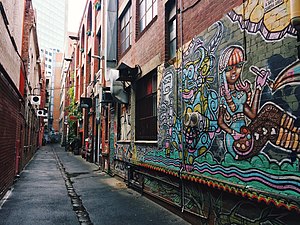


The Melbourne central business district in Australia is home to numerous lanes and arcades.[1][2] Often called "laneways", these narrow streets and pedestrian paths date mostly from the Victorian era, and are a popular cultural attraction for their cafes, bars and street art.
The city's oldest laneways are a byproduct of Melbourne's original urban plan, the 1837 Hoddle Grid, and were designed as access routes to service properties fronting the CBD's major thoroughfares.[3][page needed] By the 1850s gold rush, Melbourne had over one hundred lanes, some of which became associated with the city's criminal underbelly, notably those in the Little Lon district. Melbourne's shopping arcades, among the best known being the Block Arcade and the Royal Arcade, reached a peak of opulence during the late Victorian era. Since the 1990s, many lanes in Melbourne have become pedestrianised and undergone gentrification. Recognised today for their heritage value, they frequently feature in tourism promotions, and attract visitors from throughout Australia and the world. A number of laneways, such as Hosier Lane, are street art hotspots, and referred to as "laneway galleries".
St Jerome's Laneway Festival, often referred to simply as Laneway, is a popular music festival that began in 2004 in Melbourne's laneways.
- ^ "Little Latrobe Street and the Historical Significance of Melbourne's Laneways". Public Record Office of Victoria. Retrieved 25 April 2020.
- ^ "Melbourne Laneways". melbourneheritage.org.au. Retrieved 25 April 2020.
- ^ Bate, Weston (1994). Essential But Unplanned: The Story of Melbourne's Lanes. State Library of Victoria in conjunction with the City of Melbourne. ISBN 9780730635987.
